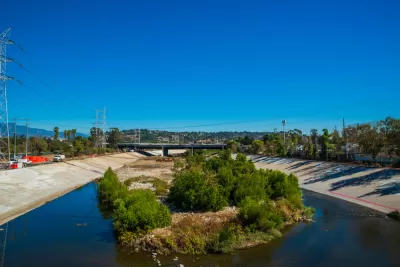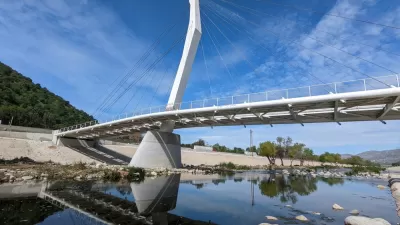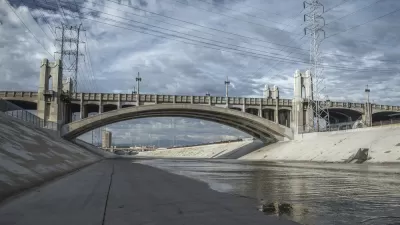Five themes proposed to achieve justice and sustainability for the Los Angeles River and its surrounding communities.

The draft Los Angeles River Master Plan recently completed public comment. The draft is a very informative and accessible document, which lays out, and tries to address, some of the largest challenges facing the river.
Key issues (some included in the Master Plan, some not) that public officials and private investors should consider while finalizing this plan include:
- Managing knowledge
- Protecting the environment
- Reducing gentrification
- Physical footprint
- Promoting transparency and monitoring
Addressing these challenges and mitigating negative impacts will transform the L.A. River and ensure a sustainable and just river for the coming generations.
Managing Knowledge
The Master Plan lays out the blueprint for this once-in-a-century project to transform a large swathe of the city and with the city's extremely checkered past of urban planning and injustice, this generation better get it right or risk being on the wrong side of history, again.
No shortage of "what could have been done" or more accurately "should have been done" exists, but these learnings should act as a stencil for the L.A. River project. The L.A. River project should take all of these and ensure that "never again" actually means never again.
In that respect, knowledge from historians, former public officials, and civil society organizations should be captured and transferred to policy makers to ensure that urban planning is more just. From redlining to destroying neighborhoods with freeways to rampant gentrification, the lessons are enormous.
A systematic approach to gathering and applying lessons from the past should be an integral part of any major undertaking. Such an approach creates a culture of learning, from which present and future generations can profit.
Ensuring that "never again" is less a slogan and more a part of the city's DNA, both government and nongovernment forces and sources need to play a key role. Multistakeholderism is taking hold around the world in a variety of fora, such as the Extractive Industries Transparency Initiative (EITI, covering oil, gas and mining revenues) and the Kimberley Process Certification Scheme (addressing "blood diamonds"). A multi-billion project in the City of Angels (indeed potentially tens of billions) should be no different.
Protecting the Environment
With a mission to "protect and enhance California's coast," the California Coastal Commission has staunchly protected the California coast from undue commercial real estate influence and possible negative impacts. While overly cautious at times, the Commission has protected the environment and the interests of coast users, not just the wealthy few.
Compared to unregulated coastal development in Croatia or the Crimea (in the latter, private property to the water's edge, fenced to the water), California should be proud of having a regulatory body that ensures that human imprint and impact is kept to a minimum.
Given the L.A. River's ecology, should there be a regulatory body to oversee the entire section of impacts from Mile 1 to Mile 51? Rivers don't live in silos and neither should public servants.
The strain on city services will likely rise—commercial and residential buildings require water and usually have parking spaces, to mention just two examples. Los Angeles should show leadership by abandoning parking minimums for housing. Following UCLA's Donald Shoup (the "Moses of Parking"—thou shalt not park for free), erasing parking minimums would have a large impact. Having a river that can be accessed and traveled by bike along large parts of its length (like Paris and London) will reduce traffic and directly, positively impact community health. Indeed, an interactive map models several crowded areas showing parking availability and the impact of reducing parking to make way for housing.
Reducing Gentrification
Gentrification is the elephant in the room. The Master Plan touches on the subject without actually mentioning the word, as part of its "6th Goal" regarding housing and the negative impacts of development. The housing crunch centers around Downtown L.A. and Long Beach, but affordability challenges are pressing all along the river.
With the planned beautification and access to parks, areas will be more attractive and available, creating parking "creep" in surrounding neighborhoods and new demand for housing in the neighborhood. Neighborhoods along the river that aren't currently experiencing housing scarcity will likely be soon. As the quality of the river environment improves, real estate agents will mention river access as an additional asset.
In peripheral neighborhoods, a potential rush of buyers is likely and should spur the requisite planning. Indeed, the Master Plan lays it out in black and white—one in four Californians lives within one hour of the river. That is quite a magnet and a rush of buyers can be expected.
To help alleviate the stress and build communities, county officials should consider the following principles:
Embrace the 15-minute city concept – With this concept, all essential services and amenities can be reached using public transport, biking, or walking within a quarter of an hour. While it is hard to imagine any U.S. metropolis within striking distance of the coveted 15 minutes or under, Los Angeles should try, and try hard, to reach that goal. This policy would reduce strains on the city's transportation infrastructure and the millions of hours wasted in commuting to work and to shop.
Promote home ownership – Low interest rates present a significant opportunity for homeownership, despite the pandemic. As the quality of life improves in some areas around the river, prices will go up and ownership will change. Boyle Heights and West Oakland in the East Bay Area are perfect examples or that. Civil society organizations (CSOs) discussing these topics in multiple languages should be part of any master plan. Financial literacy is a crucial aspect to justice.
Consider housing unit size – California's housing unit size is the smallest of any state, with an average unit size of 837 square feet. Seattle is the smallest city with 711 square feet with challenging weather. Los Angeles has a considerably larger apartment size at 792 square feet. With only one river, and as one of the world's largest metropolises, the demand for housing along the river in Los Angeles will require some people to live in smaller units. Space is too much of a premium for lofts. The Casitas Lofts, which offered a paltry 10% of its units for affordable housing, are a case in point. Lofts near transport hubs or with nearly exclusive access to parks would be as unjust as freeways.
Public ownership of housing – The Master Plan discusses land banks, in which the public agencies can purchase or hold land in the short-term to sell to the private sector for future development. Policymakers should go one step further—own and develop the land forever. An interactive map on public agencies that own land in the area is revealing. Initiated by L.A.'s Controller Ron Galperin, the map scopes the ownership of public agencies. Some German cities wholly own companies with the mission to build affordable housing. These entities have proven the concept that social mission and economic activity are not a contradiction. Given that hundreds of lots in the city and county are vacant, the economic upside of developing publicly owned land in Los Angeles must be in the billions. Los Angeles should consider having its own building entity, which provides a responsible and sustainable approach to the city's housing. It can lead by example—promoting justice and sustainability simultaneously. At the very least, an absolute freeze on any selling of public land should take immediate effect. If there is any transaction, it should be leased, but not sold outright.
The Physical Footprint
In addition to soft policies designed to mitigate gentrification and protect the environment, the following three issues will help to shape a more enlightened and just physical space.
The built environment – It is likely that an inordinate amount of buildings will be built along the corridor, so sustainability has to be the priority. Leadership in Energy and Environmental Design (LEED) rates buildings in energy, energy efficiency, environmental impact, water use, and footprint. A blanket policy should demand that all commercial and residential buildings are LEED Platinum, the highest level, to ensure that the environmental footprint and energy use are minimized. Finally, each building should roll out "materials passports" to increase recycling at the end of a structure's life cycle, to help spur participation in the circular economy.
Parks and recreational space – Some of the river's adjacent communities are the most park starved in the county, and the Master Plan rightly addresses it in the document's second goal. Neighborhoods along the river with the smallest amount of park space include:
- Compton - .6 acres per 1,000
- East Rancho Dominguez - .4 acres per 1,000
- Maywood - .3 acres per 1,000
With L.A. County's average park space at about 8.5 acres for every 1,000 citizens, East Rancho Dominguez and Maywood have 20-25 times less park space than the county average. Congratulations are due to the Master Plan for highlighting this in its second goal. If the plan delivers, the liveability around some neglected neighborhoods will improve significantly.
Community bridge building – Most bridges crossing the river are meant for cars and large vehicles. Therefore, it is important that small pedestrian and cycling bridges are constructed, connecting communities with active transportation routest. Aesthetically pleasing simple structures, using Accelerated Bridge Construction (ABC), would allow more exchange on both sides.
These bridges would facilitate community interaction and duly promote cycling corridors, providing alternatives to more dangerous main arteries. From a structure to a concept, bridges could also help to promote dialogue and exchange through areas to sit in the middle, allow both sides of the river to "build bridges" among themselves.
Promoting Transparency and Monitoring
The L.A. River contracting process must be transparent and requires vigilant monitoring for its soft and hard impacts in the coming generations.
Contract Transparency – In the notoriously opaque extractive sector, the momentum toward contract transparency reached a crescendo in January when countries belonging to the Extractive Industries Transparency Initiative (EITI) pledged to publish their oil, gas and mining contracts. Some of EITI's 55 member countries—Nigeria, Democratic Republic of the Congo and Kazakhstan—routinely fare poorly in Transparency International's Corruption Perceptions Index (CPI). American transportation, in which there are tens of billions of dollars at stake, could take a page out of EITI's hymnal. The publication of large-scale contracts (e.g., for freeways, bridges, and feasibility studies) would create more accountability in the private and public sectors and facilitate financial literacy among communities. After all, billions of dollars, impacting millions of people, are at stake.
Constant evaluation – With leading universities located within an hour of the L.A. River, several could form a consortium, acting as a neutral third-party, offering mountains of data regarding the Master Plan's impacts for the coming decades. UCLA, USC, Occidental, and Cal Poly Pomona all have very solid faculties in environment and urban planning. Given the Master Plan's complexities, a stand-alone unit could measure the impacts on an annual basis as a complement to civil society organizations.
Conclusion
The impacts of the vision expressed by the L.A. River Master Plan on those living adjacent to the river are and will be enormous. Our shared goal should be to bolster the positive impacts of the plan and do our collective best to mitigate the negative impacts as the Master Plan goes from paper to policy to practice.
L.A.'s freeways are a monument to cutting out and cutting off those with little or no voice. With the L.A. River, while we cannot change history, we can certainly learn from it. If we can do that, then we will succeed in transforming 50 miles of river in a climate-challenged metropolis.
One man's developer is another man's destroyer. If some of these ideas are implemented, developers might not make a financial killing like the days of yore, but they will do more than a respectable business.
Lewis MacAdams, the L.A. River's patron saint, summed up his philosophy succinctly: "If it's not impossible, I'm not interested." Many may view some of the above proposals as unrealistic or impossible.
Well, that should be the ticket to entry for the project of the century. With that "impossible, but I'm in" attitude, those courageous and long-term thinking public servants and responsible private companies will achieve immortality. Most importantly, Los Angeles and its concrete channel- turned-river will serve as not only a place of community but as a lighthouse around the world not only talking sustainability and justice, but proudly walking it.
An Angelino now based in Germany, Richard Dion works in the Governance and Human Rights Unit at GIZ, the German Corporation for International Cooperation GmbH.

Planetizen Federal Action Tracker
A weekly monitor of how Trump’s orders and actions are impacting planners and planning in America.

Chicago’s Ghost Rails
Just beneath the surface of the modern city lie the remnants of its expansive early 20th-century streetcar system.

San Antonio and Austin are Fusing Into one Massive Megaregion
The region spanning the two central Texas cities is growing fast, posing challenges for local infrastructure and water supplies.

Since Zion's Shuttles Went Electric “The Smog is Gone”
Visitors to Zion National Park can enjoy the canyon via the nation’s first fully electric park shuttle system.

Trump Distributing DOT Safety Funds at 1/10 Rate of Biden
Funds for Safe Streets and other transportation safety and equity programs are being held up by administrative reviews and conflicts with the Trump administration’s priorities.

German Cities Subsidize Taxis for Women Amid Wave of Violence
Free or low-cost taxi rides can help women navigate cities more safely, but critics say the programs don't address the root causes of violence against women.
Urban Design for Planners 1: Software Tools
This six-course series explores essential urban design concepts using open source software and equips planners with the tools they need to participate fully in the urban design process.
Planning for Universal Design
Learn the tools for implementing Universal Design in planning regulations.
planning NEXT
Appalachian Highlands Housing Partners
Mpact (founded as Rail~Volution)
City of Camden Redevelopment Agency
City of Astoria
City of Portland
City of Laramie





























